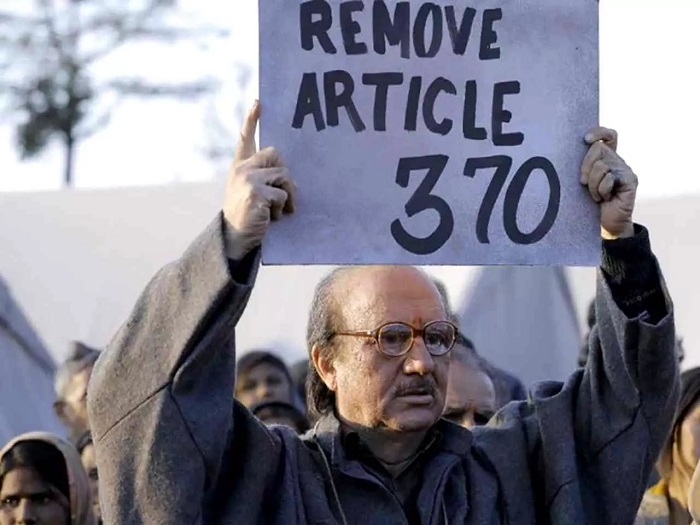Films like Kashmir Files need to be promoted to shine light on our dark past
- By : Anirban Ganguly
- Category : Articles

After independence, over the last seven decades a number of narratives have faced with suppression or annihilation from our collective memory. The story of how the Kashmiri Pandits were driven away through a genocidal movement and turned into refugees in their own country was continuously sought to be downplayed by successive Congress regimes and leaders as well as by the communist parties.
The story of the eastern partition and pogroms that followed it for decades after the event, the story of how the Bengali Hindus were driven out of their ancestral lands and their homes and forced to eke out a miserable existence on the pavements of Kolkata and the forests of Dandakaranya, were never documented or narrated.
The story of how the first Left Front government in West Bengal led by Jyoti Basu and his other left comrades ordered firing on Dalit Hindu refugees who attempted to settle in the godforsaken estuary island of Marichjhapi in Sunderbans, had never been narrated till one author took courage to dig up the narrative.
The dark phase of the Emergency, when the whole of India was turned into one mega prison house by Indira Gandhi and her minions in the Congress party, when artists were pulped and boycotted, when the political opposition was thrown in prison and tortured, is yet to be documented through a mega feature film. An essential task so that generations know and internalise the need to immerse oneself in and to protect and perpetuate our democratic and constitutional essence and fabric.
Such films need to be made in order to expose the perfidious politics played by the longest ruling political dynasty of this country – the family led Congress. This is exactly what Prime Minister Modi referred to, when he said that a film on the Emergency was yet to be made.
Those syndicates who dominated the writing and documenting of history in the last fifty years, the gatekeepers of narrative building in India, deliberately avoided, suppressed and marginalised any attempt to document these excruciating episodes in the history of free India. These episodes, in fact, shake the very foundation of our democratic polity and question India’s constitutional basis. In their heyday, these cartels, controlled and strangulated any event – however ghastly and shocking they may have been – which questioned or exposed their duplicitous secular narratives and ideological frameworks.
While they championed freedom of expression and the right to differ in forums across the world, at home they practiced an intellectual and cultural apartheid, suppress or boycott those who have a different story or a differing dimension to narrate and highlight. Heap calumny on them or try and debunk their documentation and research. Instead of trying to counter a film by a film, a book by a book, a play by a play, instead of trying to disseminate their version of a historical episode, all that the communist driven and Congress sustained intellectual and academic cartels did was to suppress these attempts, to terrorise publishers into withdrawing their consent to publish, to pressurise institutions and forums that gave such alternate narratives space.
The exodus of the Kashmiri Pandits, the genocide perpetrated on them fell victim to the monopoly of these cartels. The story was never narrated, even when narrated, it was done in a motivated and piecemeal, trying to justify the reasons for this exodus and why it came about – in short each time terrorists and separatists, who peddled and pushed the Pakistan agenda in Kashmir were accorded the benefit of doubt, their gory acts justified, till the Kashmir Files came.
The reason why the Kashmir Files cannot be wished away or suppressed is the mass response that it has elicited. Based on unassailable research and facts, expertly and unnervingly depicted in terms of cinematography by some of the tallest names in the industry, the Kashmir Files has actually shaken our collective conscience.
Cinemas can generate movements or can depict them; in this case, it has generated a movement, it has shaken a large number of youth, who either vaguely knew of this genocide, or had no idea of its intensity and inhumanity. The Kashmir Files has shown the mirror to those who kept silent, looked the other way or actively abetted the crime of displacement and genocide of Kashmiri Pandits. It is these people who are shouting loudest against it, or trying to deflect the blame for it onto others.
The Kashmir Files has resurrected old debates and unhealed wounds. It has shaken from stupor an entire generation of self-styled leaders and opinion makers and champions of human rights, who kept silent on seeing their Prime Minister shake hands with the kingpin of the terror outfit JKLF Yasin Mallik, who was at the forefront in gunning down innocent civilians, men in uniform and in implementing Pakistan’s diabolic agenda in Kashmir.
It has reminded an entire generation and educated another on how, once upon a time in Kashmir, Kalashnikov wielding crowds hurling blood-curdling slogans such as ‘Noor-e-Chasm, Noor-e-Haq, Zia-ul-Haq, Zia-ul-Haq’ or ‘Pakistan Zindabad, Khalistan Zindabad’, ‘Muslim-Sikh Bhai Bhai, Hindu Quam Kahan se Ayee’, were commonplace. It tells them of an era in Kashmir when ‘Pakistan Independence Day’ August 14th was celebrated and hartal and blackout was observed on India’s independence day, when Srinagar was daily rocked with explosions, when the National Flag was burnt in full public view with crowds standing and applauding.
Those who are trying to block the Kashmir Files are only exposing their own past complicity and their present commiseration with the genocide and perpetrators of the genocide of the Kashmiri Pandits. Let them make another film to narrate their point of view, if they have one at all, trying to suppress the Kashmir Files is like trying to douse the flames of an awakened national consciousness. It is something which shall not happen anymore in a new India.

















